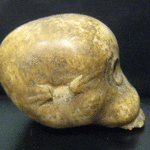Japanese Whalebone Netsuke of a Human Skull, 1850 CE - 1900 CE
Whalebone
1.75 x 1.25
OF.070
Netsuke sculptures are designed to attach the tops of sagemono (containers) – which contained personal items – to the obi (sashes) used to tie the kimono or kosode. They are...
Netsuke sculptures are designed to attach the tops of sagemono (containers) – which contained personal items – to the obi (sashes) used to tie the kimono or kosode. They are therefore essentially utilitarian objects, but since the 17th century craftsmen and artists have taken great pleasure in carving ever more complex and detailed themes onto netsuke so that they are now recognised as one of Japan's most notable indigenous art forms. There are various different forms – over and above the thousands of designs – of which the in-the-round carving of kataborinetsuke (lit. “sculpture netsuke) is the best-known. All forms of ivory and bone are used; judging from the texture and colour of this piece, it has been made from the excruciatingly hard bones of whales.
The current piece is unsigned, and probably dates to the latter half of the 19th century when there was a plethora of new styles and enthusiasm for netsuke was at its peak. It depicts a human skull, using an interesting combination of anatomically correct and naïve elements. The calvarium is correctly proportioned, with a high frontal (implying a female individual)and a rounded vault that is rounded-oval in vertical view. The temporals and occipital are depicted as being one solid mass, presumably for increased structural integrity, and the facial bones are uniform and undelineated. The pyriform aperture (nose) is correct, if somewhat small, and the palate is broad and shallow with eight spatulate anterior teeth (somewhat short of the correct 16). The eyes are perfectly circular - drilled, then enlarged internally. The zygomatic arches are roughly correct; the fact they have symmetrical breaks in the exact centres suggests that the sculptor was intending to portray the skull of a child, in which the zygomatic arches (lateral aspects of the cheekbones) do not fully fuse until the age of about 7. There are two joined perforations forming a loop of bone on the underside of the skull, where it was hung from the sash. Surface detailing is limited yet effective. The frontal suture is present, again implying a young individual (this fuses at about 5); the alveolar process is rounded above the teeth; the eyes have 'ghost' circles arond them, perhaps indicating the extent of their future growth into adulthood.
The surface is worn in a very specific manner. The apical portion of the skull is matte, with the dark matter of the cancellous bone showing through in irregular patches. The sides and main part of the face are dull gloss, while the forehead, the occiput (back) of the skull and the base around the perforations are all mirror gloss, implying long-term use and rubbing against garments. Based on the use wear patterns, and reconstructing the original apparel, it seems that the back/base of the skull was rubbing against the sash, so that the face was inclined and facing almost straight down. When at this angle, the forehead would have been rubbed as well, by the exterior portions of the garments, while the rest of the head was essentially untouched. This is a well-made and well-used netsuke, and a worthy addition to any good collection of such pieces.
The current piece is unsigned, and probably dates to the latter half of the 19th century when there was a plethora of new styles and enthusiasm for netsuke was at its peak. It depicts a human skull, using an interesting combination of anatomically correct and naïve elements. The calvarium is correctly proportioned, with a high frontal (implying a female individual)and a rounded vault that is rounded-oval in vertical view. The temporals and occipital are depicted as being one solid mass, presumably for increased structural integrity, and the facial bones are uniform and undelineated. The pyriform aperture (nose) is correct, if somewhat small, and the palate is broad and shallow with eight spatulate anterior teeth (somewhat short of the correct 16). The eyes are perfectly circular - drilled, then enlarged internally. The zygomatic arches are roughly correct; the fact they have symmetrical breaks in the exact centres suggests that the sculptor was intending to portray the skull of a child, in which the zygomatic arches (lateral aspects of the cheekbones) do not fully fuse until the age of about 7. There are two joined perforations forming a loop of bone on the underside of the skull, where it was hung from the sash. Surface detailing is limited yet effective. The frontal suture is present, again implying a young individual (this fuses at about 5); the alveolar process is rounded above the teeth; the eyes have 'ghost' circles arond them, perhaps indicating the extent of their future growth into adulthood.
The surface is worn in a very specific manner. The apical portion of the skull is matte, with the dark matter of the cancellous bone showing through in irregular patches. The sides and main part of the face are dull gloss, while the forehead, the occiput (back) of the skull and the base around the perforations are all mirror gloss, implying long-term use and rubbing against garments. Based on the use wear patterns, and reconstructing the original apparel, it seems that the back/base of the skull was rubbing against the sash, so that the face was inclined and facing almost straight down. When at this angle, the forehead would have been rubbed as well, by the exterior portions of the garments, while the rest of the head was essentially untouched. This is a well-made and well-used netsuke, and a worthy addition to any good collection of such pieces.



